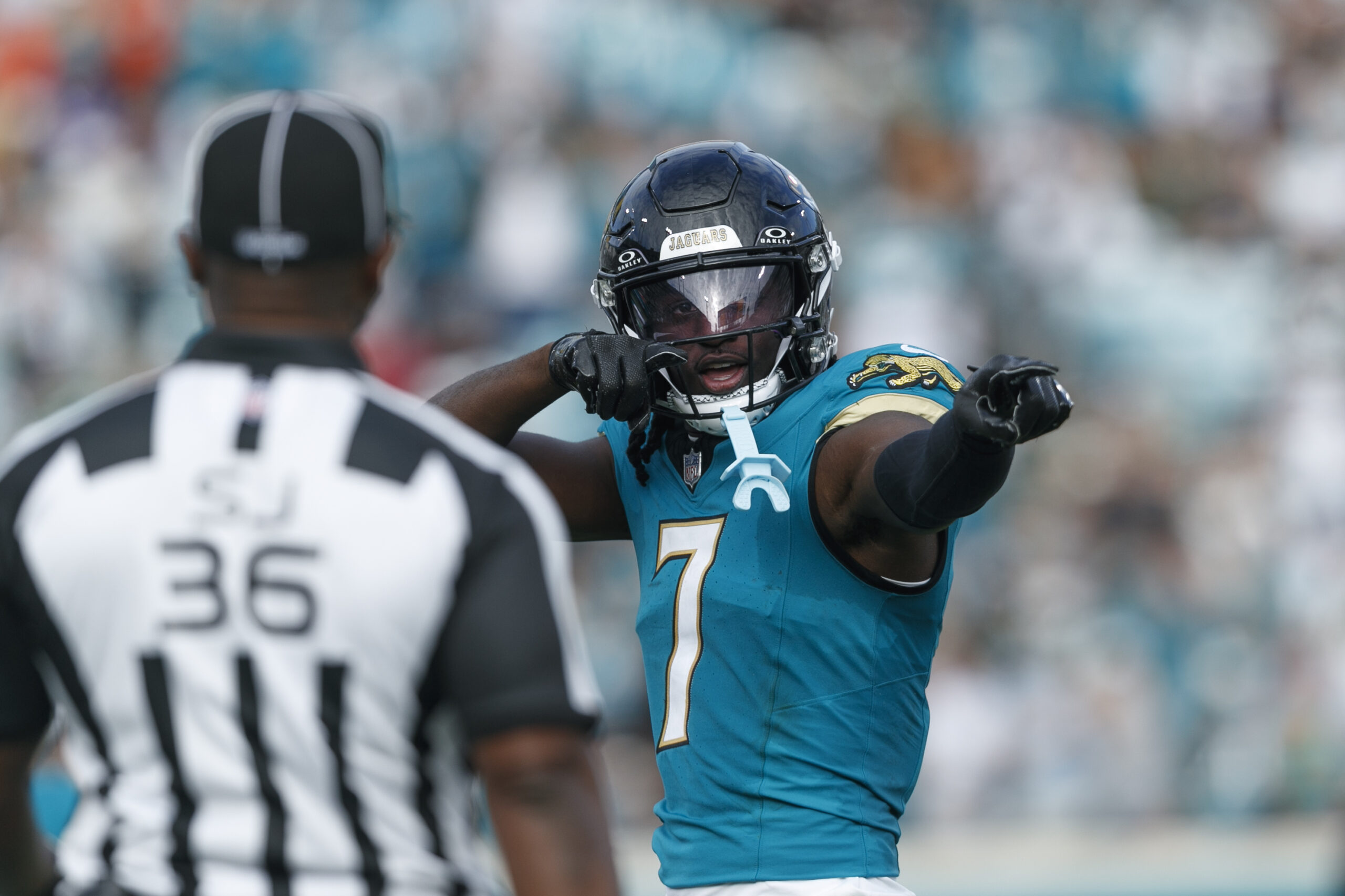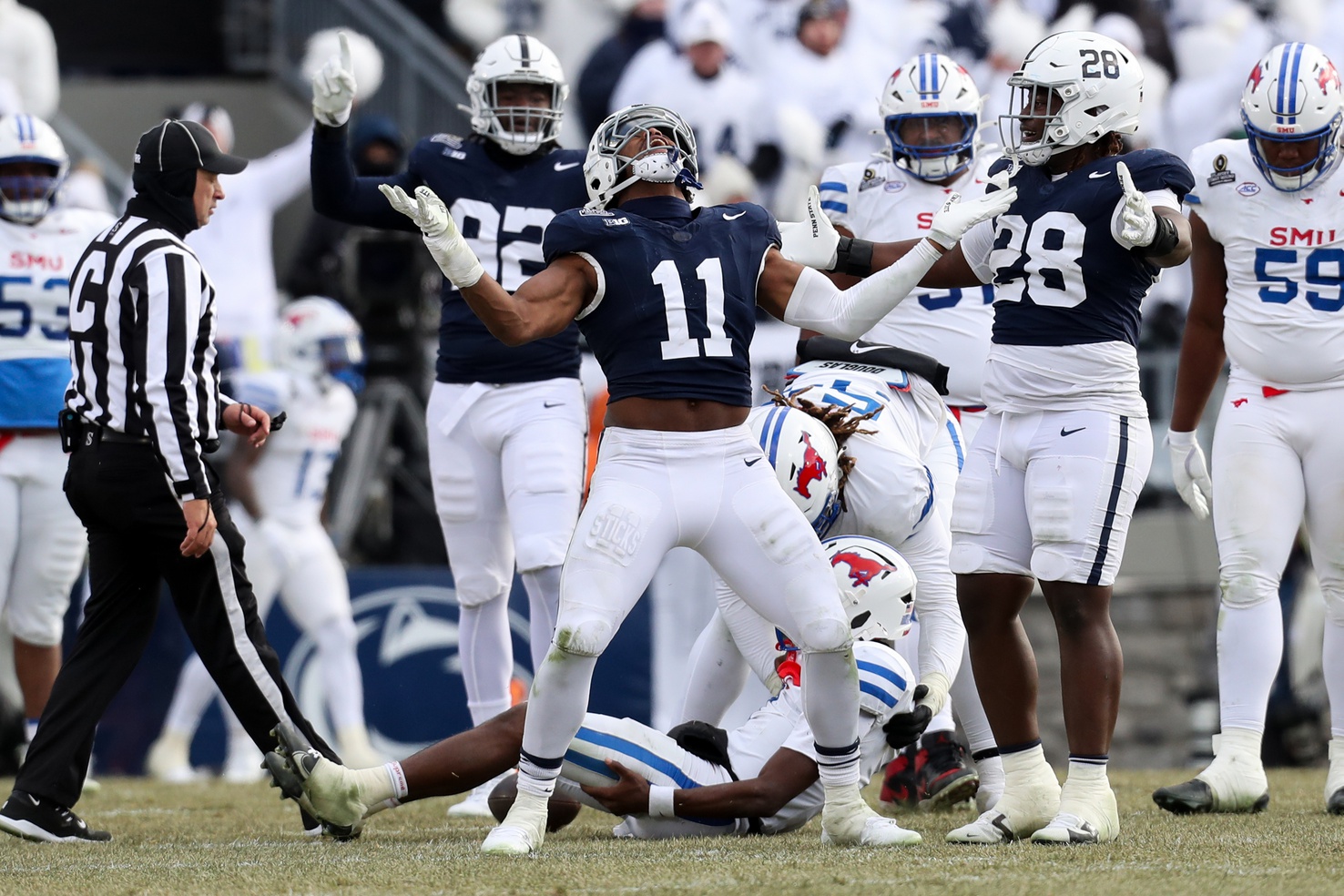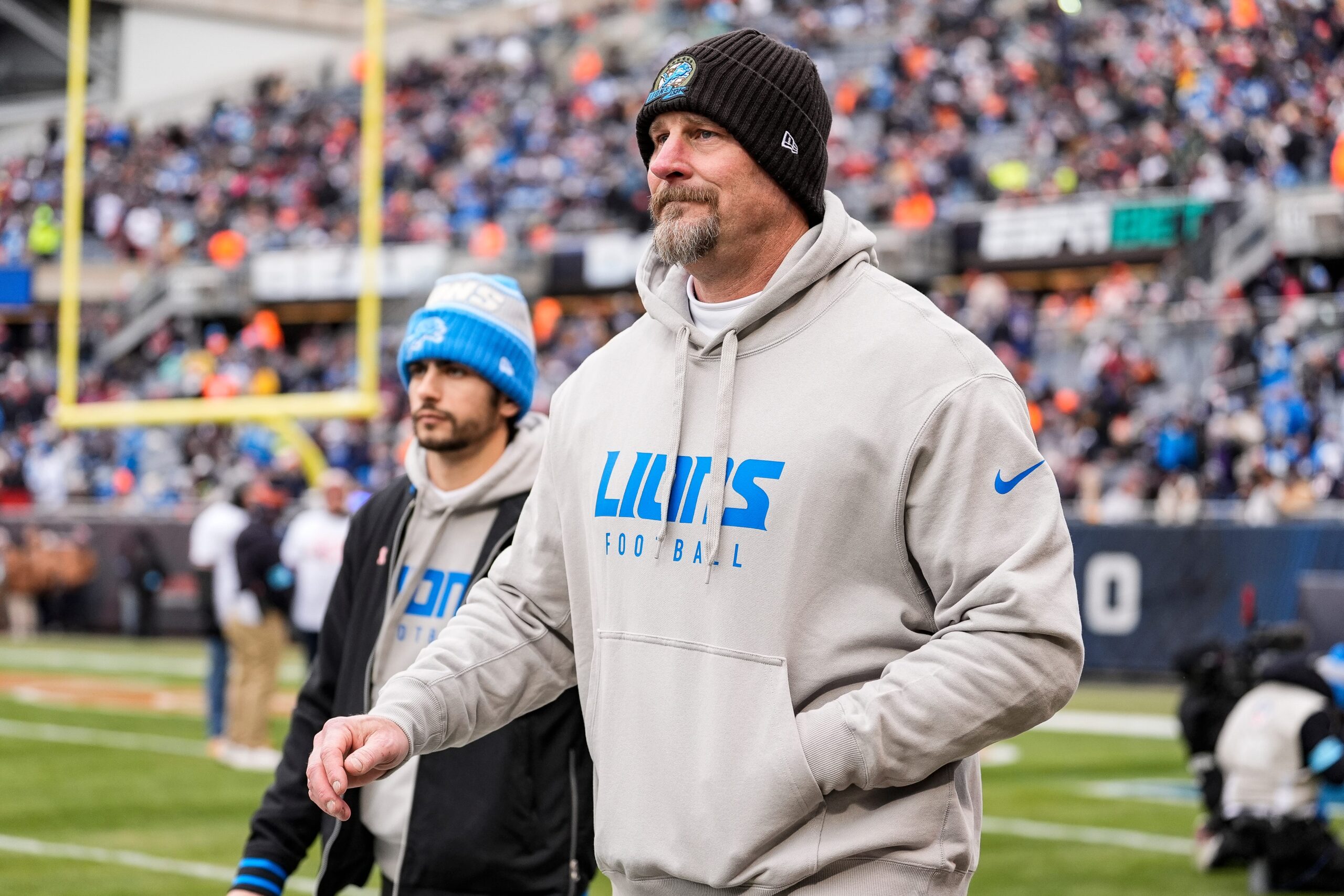NFL Analysis
12/23/24
20 min read
1st & 10 Week 16: Commanders Comeback, Vikings Exciting Win, Lions Big Plays & More

Each week, 1st & 10 will bring you a Monday morning in-depth breakdown of everything you need to know from Sunday’s slate of games.
We’ll fill this column with stats, film, and plenty of words to keep you covered on anything you might have missed or want to dive deeper into from Sunday.
All stats provided by TruMedia unless noted otherwise
1st & 10 NFL Week 16
1. Commanders Made A Comeback
With 2:07 remaining in the game and the Eagles up 30-28, Philadelphia had a third-and-5 on Washington’s 22-yard line. DeVonta Smith ran wide open for what would have been a game-clinching first down, but he dropped the ball.
After a field goal, Washington got the ball back and drove 57 yards in nine plays and 1:52 for a game-winning touchdown. The 36-33 win capped a comeback in a game in which the Commanders trailed 21-7 in the first half.
It was a wild game for the Commanders that featured five Washington turnovers. Washington scored a touchdown on 38.5 percent of its drives and also turned the ball over on 38.5 percent of its drives. It’s just the 11th time a team each scored a touchdown and turned the ball over on at least 35 percent of drives in a game. Only four, including Washington, won. The 2022 Bills did so twice in Week 1 and Week 16.
Jayden Daniels came through with some big plays on late downs and in the red zone. Washington was three-of-four on red zone trips, including the game-winning touchdown. The Commanders set those touchdowns up by spreading the Eagles out near the goal line and taking advantage of open space.
On the first touchdown, the Commanders went trips to the ride side with only Zach Ertz inline to the left. Washington got Chauncey Gardner-Johnson to jump what he thought was going to be an out-breaking route before Jamison Crowder went vertical to the back of the end zone.
— Dan's Clips (@dansfilmclips) December 23, 2024
The next time Washington got down there, the Commanders came out in a similar look with John Bates as the inline tight end. This time, Olamide Zaccheaus did run an out from the No. 2 spot, and Daniels found him after buying some time on the run.
— Dan's Clips (@dansfilmclips) December 23, 2024
For the game-winning touchdown, Washington went empty and ran a switch release inside with Ertz and Crowder. That allowed Crowder to run behind linebacker Zach Baun — who has been incredible this season but shouldn’t be covering slot receivers — and Daniels had an open window for the score.
— Dan's Clips (@dansfilmclips) December 23, 2024
Overall, Daniels averaged 0.31 EPA per play in what was likely the exclamation point on an Offensive Rookie of the Year candidacy. The Washington run game did not work, as the Eagles overwhelmed the Commanders’ offensive line. Brian Robinson had just 24 yards on 10 carries. Daniels used his legs as a threat and totaled 81 yards on the ground.
Daniels had two big runs. One was a 30-yard gain on a fourth-and-11 that set up a touchdown to bring the Commanders within six points.
Then, on the final drive, Daniels had a 12-yard run on a first-and-10 that set Washington up just outside the red zone.
This was also the best touch passing game Daniels had down the field. He had a deep touchdown to Terry McLaurin on a third-and-8.
That was preceded by a 51-yard throw to Dyami Brown that kicked off the drive from Washington’s 4-yard line.
The Eagles were aggressive in trying to take it to Daniels. Philadelphia has not been a heavy blitz team under Vic Fangio, but the defense eclipsed a 20 percent blitz rate for the third time this season. Philadelphia’s 26.7 percent blitz rate was second only to a 27 percent rate in the season opener against Green Bay. But against the blitz, Daniels was 9-of-12 for 160 yards and three touchdowns. He averaged 1.11 EPA per play with a 12.5-yard average depth of target and 2.30 seconds to throw.
On third and fourth downs, Daniels averaged 1.17 EPA per play with a 10.1-yard aDOT. Washington trusted him to make a play by going empty on 45.5 percent of snaps.
Despite Washington’s comeback effort, this could have been a different game if Jalen Hurts had not suffered a concussion early in the first quarter. Going from Hurts to Kenny Pickett was not only a dropoff at quarterback, but it impacted Philadelphia’s running game and how Washington could defend it.
The Eagles had 79 yards on eight rushes with four gains of 10 or more yards while Hurts was in the game. But once Pickett came in, the Commanders put more focus on the run and loaded the box.

Washington basically dared Pickett to beat them, and while there were some good throws — he had an early touchdown on a slant to A.J. Brown, and Brown later bailed him out on an underthrown deep ball — Pickett averaged -0.06 EPA per play with a 43 percent success rate.
There was no update on Jalen Hurts after the game, so his status is still unknown going forward.
With the loss, the Eagles severely limited their shot at a first-round bye. Per The Athletic’s playoff model, Philadelphia now has a six percent chance at the top seed in the NFC, behind the Lions and the Vikings. But the division should not slip away with a 98 percent chance to win it.
Washington now has a 94 percent chance to make the playoffs.
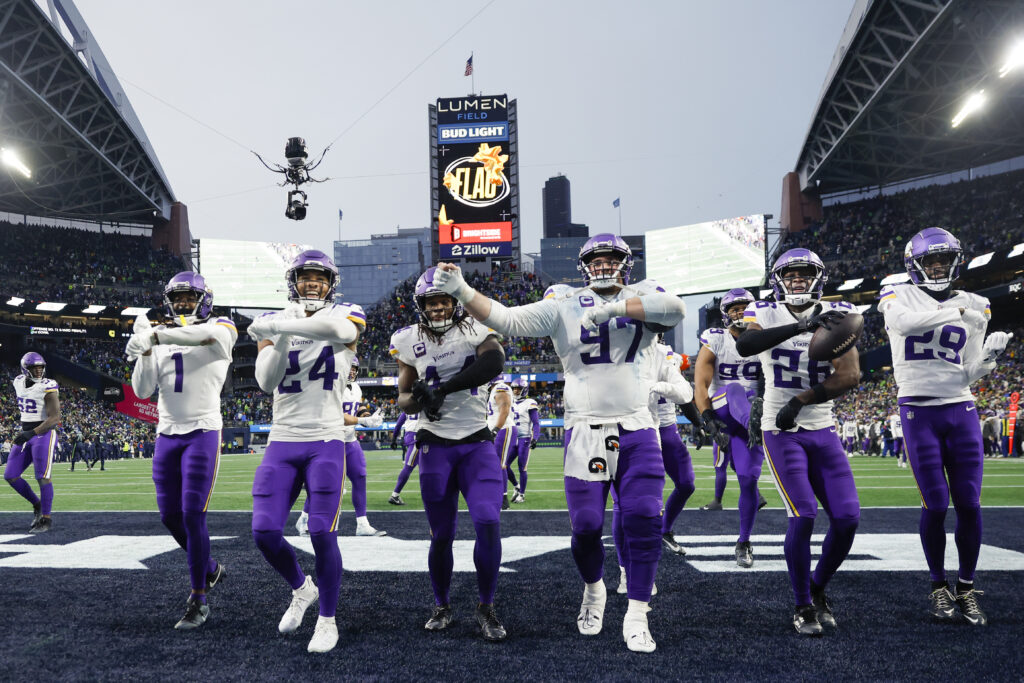
2. Vikings Can Still Be The NFC's 1-seed
The Minnesota Vikings keep winning. After a thrilling 27-24 victory against the Seattle Seahawks, the Vikings moved to 13-2, a record that was nearly unthinkable for this team before the season started.
Everything continues to come together for Minnesota, a team that still has a shot at the NFC North and the first-round bye.
This wasn’t the best Sam Darnold game overall, but it’s been proven that these games don’t have to be for the offense to have success. Darnold made big throws when it mattered, including the go-ahead touchdown to Justin Jefferson, which Darnold called when the headset communication between him and head coach Kevin O’Connell went out.
On the play before that pass to Jefferson, Darnold was hit and was hobbling back into the huddle after a third-down sack that could have ended the drive if not for a facemask penalty on the tackle that gave the Vikings a first down.
But playing in this offense has given Darnold the confidence to make those types of throws and the knowledge that something will be there for a big play even after a mistake.
Of course, things were not easy for the Minnesota offense. Darnold was hit seven times and sacked on three of them. When pressured, Darnold had a 23 percent success rate with -0.42 EPA per play. But when Darnold did make plays under pressure, they were great. His average depth of completion under pressure was 14.3 yards, including that throw to Jefferson.
There’s trust in everything, and it certainly helps to have some of the best playmakers in the league as a supporting cast. Jefferson’s first touchdown catch came inside the red zone on a third-and-3 in the second quarter. He had a 1-on-1 on the outside and had the smoothest late separation to get under Darnold’s pass.
Jefferson ran a route on every Minnesota dropback and was dominant all over the field, en route to 144 receiving yards. He had 3.39 yards per route run outside and 3.38 from the slot. He accounted for 37.1 percent of the Vikings’ targets. He’s had at least 37 percent in each of the past two games. With two catches of 20 or more yards, he increased his lead for much such receptions — now six more (26) than the next receiver.
The Vikings' defense disrupted Geno Smith by pressuring him on 47.8 percent of his dropbacks.
Early in the game, Minnesota brought the blitz but backed off in the second half, yet they were able to create more pressure.

Smith was only sacked twice despite the pressure, and he was aggressive in throwing the ball down the field. Seattle had a 20 percent explosive pass rate but did not have an explosive run. That’s been the case for the Seahawks this season. Without an effective run game, Seattle has often abandoned it — the Seahawks had a 76.7 percent pass rate — and then asked Smith to complete the impossible task of carrying the offense with his arm.
Unlike the Minnesota situation, everything has to go right for Seattle to the offense to sustain success. Then, when there is a miscommunication like the one on the final interception intended for DK Metcalf, it’s a fatal mistake.
The Vikings now have a 28 percent chance of getting the top seed in the NFC, but it’s not going to be easy. Minnesota plays Green Bay next week and would have to win before facing Detroit in Week 18. If the Vikings win out, they would finish as the top seed.
Seattle, at 8-7, still has a shot at the NFC West title. The Rams would need to lose to the Cardinals next week for the Week 18 meeting between Los Angeles and Seattle to be in the division.

3. Lions Offense Keeps Striking
Last week, in a radio interview, Dan Campbell said the Detroit Lions would be willing to win in whatever way necessary. Against the Bears, they played as if they knew the most likely path through the playoffs is to put up as many points as possible to support a defense that has lost so many contributors.
In a 34-17 win against the Bears, the Lions averaged a week-high 0.27 EPA per play and 1.75 EPA per drive. With David Montgomery out, Jamhyr Gibbs carried the ball 23 times for 109 yards and a touchdown. But Detroit made its biggest splashes in the passing game.
We have to start with the fake fumble play.
The play, called "Stumble Bum," was designed by Ben Johnson after he saw Jordan Love actually fumble and recover on a play that turned into a big gain against the Bears earlier in the year.
To make things more unfair, Sam LaPorta ran Leak. It’s something that probably would have been open had the fake fumble not occurred, but there is no window dressing too much for this Detroit offense.
— Dan's Clips (@dansfilmclips) December 23, 2024
Jameson Williams had two more gains of 20 or more yards on his way to 143 receiving yards and a touchdown. Williams had an 82-yard touchdown where he just ran past the secondary.
He also had a 25-yard catch over the middle of the field, where he made a few defenders miss to gain yards after the catch.
As we wrote in Four Ups, Four Downs a few weeks ago, getting Williams to be a big play threat from multiple spots on the field has been one of the most fun developments from this offense in 2024.
Jared Goff averaged 0.38 EPA per play with a 52.9 percent success rate on the day. He’s now second in EPA per play on the season behind Lamar Jackson and first in success rate.
Detroit’s defense had an up-and-down day while figuring out how to best approach the current personnel. The Lions blitzed on 39 percent of Caleb Williams’s dropbacks — a 30.3 percent rate on early downs and 55.6 percent of third downs.
Williams had a productive day, averaging 0.27 EPA per play with 334 yards and two touchdowns.
The pressure did get to Williams, though. When under pressure, Williams had an 11.1-yard aDOT but just a 2.5-yard average depth of completion. There still isn’t much of a plan for the Bears when under pressure or against the blitz, so when the Lions got home, the Bears struggled.
Detroit’s defense still finished ninth in EPA per play and seventh in success rate for the week, but much of that came from holding the Chicago run game in check. The Lions were 24th in EPA per dropback allowed, which is a concern that might not get much better for the rest of the season.

4. Bills Survive Patriots
This was a weird game for the Buffalo Bills, a narrow 24-21 win against the three-win Patriots.
Josh Allen didn’t have a lot going for him in the passing game. He finished with 0.02 EPA per play, his lowest since Week 10 and an abrupt end to a three-game hot streak in which he averaged no less than 0.47 EPA per play in a game.
The Bills had eight players catch a pass, but no one had more than 26 receiving yards. Allen had an 11.0-yard aDOT but just a 5.3-yard average depth of completion. New England played man coverage on 46.6 percent of plays, and Allen averaged -0.19 EPA per play with 3.4 yards per attempt. There was little separation, and Allen couldn’t do much to make plays on his own.
Allen went back to some of his reckless decision-making while trying stuff on third-and-longs.
Buffalo got the ground game going with James Cook, who finished with 100 yards and a touchdown, but he only had 11 carries.
Defensively, the Bills struggled to stop Drake Maye, though there was a similar man-zone split on that side of the ball, too. Against man coverage, Maye averaged -0.26 EPA per play and 4.1 yards per attempt, while he averaged 0.39 EPA per play and 8.2 yards per attempt against zone. The Bills played man on 38.2 percent of plays.
Maye had some nice throws in the game, including an early touchdown to Kayshon Boutte.
He finished with 0.19 EPA per play, the 11th-best mark of the week, despite being pressured on 40 percent of his dropbacks. Maye’s ability to maneuver in the pocket has been a plus trait this season, and it allowed the Patriots to hang in a game that the Bills were daring the quarterback to beat them without much fear of the supporting cast.
Buffalo got away with it, but this wasn’t the type of impressive defensive performance that should make the team feel good after giving up 86 points combined during the previous two games.

5. Michael Penix Debut
Michael Penix Jr. had an impressive debut for the Atlanta Falcons. He was smart and decisive, while his lack of physical limitations accentuated what had already been working in the Atlanta offense.
There was a lot to like structurally about the Falcons' performance for much of the season, and early in the year, it worked with Kirk Cousins. But Cousins never improved physically after his Achilles injury, and his movement looked worse throughout the year. The change to Penix was needed if the offense was going to have a chance to make a push to the playoffs.
The Falcons kept things simple, and a lot of the offense still looked the same. The first play of the game was a bootleg off play-action to prove a point (though it was dropped), but Penix only used play-action on 19 percent of his dropbacks. Atlanta stuck with heavy pistol usage, taking 55.4 percent of snaps in the pistol.
This was a Cousins-like game plan with a more functional quarterback. Penix averaged 2.38 seconds to throw — something the Falcons tried early in the year with Cousins to get the ball out — though Penix had more zip to throw in the middle of the field.
He struggled outside the numbers with a few drops and an interception. He did have a nice deep ball to Darnell Mooney outside, which might have been his best play of the day, but overall, he averaged -0.30 EPA per play on throws outside the numbers.
While only 37 percent of his throws were to the middle of the field, he had much better production there — 1.21 EPA per play with a 90 percent success rate.
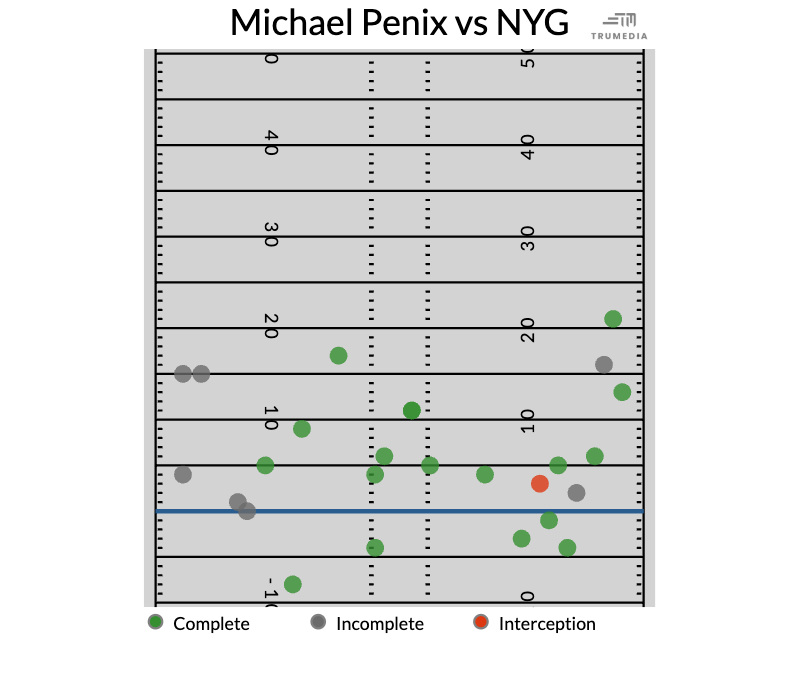
With the win, the Falcons kept their chances for the NFC South alive. Atlanta holds a tiebreaker over Tampa Bay and would be in with two wins to close out the season. A Falcons win and a Buccaneers loss next week would also send Atlanta to the playoffs.

6. Colts keep playoff hopes alive
Anthony Richardson had seven completions. There would be many times throughout the season that we would be concerned about so few completions. But Richardson only threw 11 times in a 38-30 win against the Tennessee Titans.
Richardson averaged 0.24 EPA per play on the day because he averaged 11.9 yards per attempt and added 70 yards with a touchdown on the ground. It could have been two touchdowns, but one run was ruled just short of the goal line.
He was again used as a weapon on the ground inside the red zone.
One of the most promising plays was a throw where he connected on a deep shot to Adonai Mitchell down the right sideline.
Jonathan Taylor had 218 yards and three touchdowns on 28 carries. Two of his touchdowns came on long runs of 65 and 70 yards.
The Titans had been one of the league’s best run defenses coming into this game, seventh in defensive success rate against the run. Through Week 15, they had allowed 1.31 yards before contact per rush, which ranked 10th, but the Colts averaged 3.46 yards before contact per rush in Week 16.
Indianapolis also forced Mason Rudolph into three interceptions. The win keeps the Colts alive in the playoff hunt, though they have just a 14 percent chance to get in after last week’s loss to the Broncos.

7. Is this the end of the 49ers?
The Miami Dolphins defeated the San Francisco 49ers 29-17 on Sunday. The Dolphins remain alive for the playoffs, and the 49ers are now guaranteed a losing season under Kyle Shanahan, a year removed from the Super Bowl.
Brock Purdy had a 51 percent success rate against the Dolphins but just a 4.6-yard average depth of target. The Niners only scored on 30 percent of their drives. With the Niners trailing by two, San Francisco ended the game with a four-play drive (punt), an interception, and a turnover on downs.
A year after having a historically productive offense, San Francisco is now 13th in EPA per drive and 12th in points per drive for the season. That could be considered impressive given the circumstances of this roster and the injuries faced, but this was supposed to be an offense much better than just average.
There’s going to be a lot of change for this San Francisco team based on how the team goes about contracts this offseason. The biggest domino will be the Purdy deal. While he’s done more on his own this season, he does not look like the type of quarterback who should be paid at the top of the market — the last drives of this game are proof.
Even if he slides in at a $50 million average annual salary, that’s a significant bump from the $1 million cap hit for the 2024 season. He still has a $1.1 million salary for 2025, but it’s unlikely the 49ers drag out a deal and allow a productive quarterback to play for pennies for another season.
While the 49ers are projected to have $65 million in cap space for 2025, a lot of work needs to be done to fit everyone in again, and some tough decisions will be made about who stays and who goes.
8. Chart of the day

Chuba Hubbard has been a revelation for the Carolina Panthers this season.
Through Sunday night, he’s fifth in rushing yards (though we can assume he’ll finish Week 16 sixth since he’s 48 yards ahead of Josh Jacobs, who plays Monday night — but still sixth is incredible!). He’s third in rushing yards over expected (282), according to Next Gen Stats.
Hubbard ran against a stacked box on 56 percent of his rushing attempts, but he still averaged 0.36 EPA per rush. He had 4.4 EPA alone on his 28-yard run from midfield in overtime and his 21-yard game-winner.
9. Play of the day
Joe Burrow was constantly under pressure against the Browns (41.7 percent of his dropbacks). While he was sacked four times, he made a number of impressive plays under pressure, including this touchdown to Tee Higgins while horizontal. Burrow finished the 24-6 win with 0.12 EPA per play with a 55.6 percent success rate.
The Bengals are still mathematically alive for the playoffs but are still behind the Colts and Dolphins based on conference game record; Cincinnati's is 4-6.

10. A check-in on earlier games this week
Some of the league’s best quarterbacks played earlier this week on Thursday and Saturday.
Justin Herbert had the highest EPA per play of the week during the Thursday night game against the Broncos. His 0.48 EPA per play and 58.5 percent success rate were both highs for the season for the Chargers quarterback. He averaged 0.62 EPA per play in the fourth quarter of that game.
Patrick Mahomes came into Saturday’s game with an injured ankle but didn’t show it at all with multiple long runs. Kansas City went back to the early-season strategy of getting the ball out quickly with a 2.33 average time to throw. That kept the pressure away from Mahomes, and he averaged 0.30 EPA per play, his first positive EPA since Week 12.
Lamar Jackson got past any Steelers boogeyman with a 51.5 percent success rate and 9.0 yards per attempt. It was his sixth game this season with at least 9.0 yards per attempt, tied for the league lead. With Allen’s down day on Sunday, Jackson retook the solo lead for EPA per play on the season (0.28).


